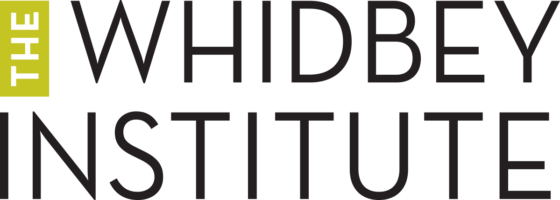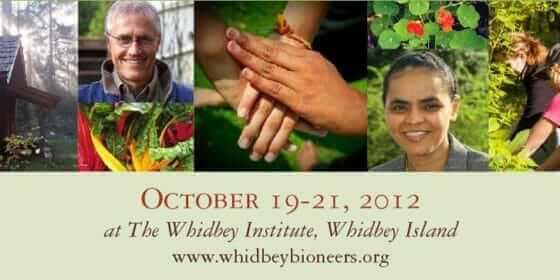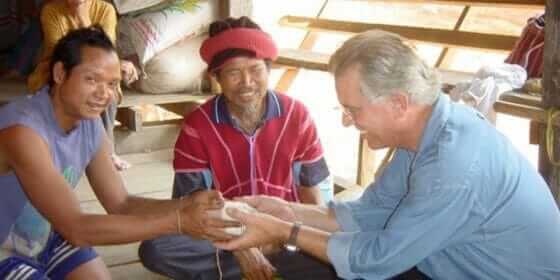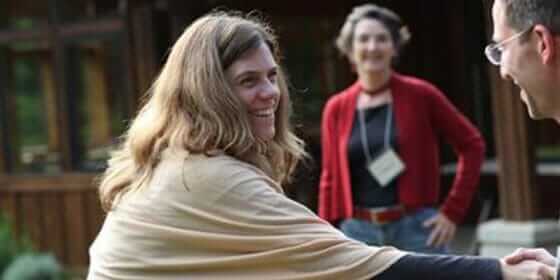One of the the Whidbey Institute’s most enriching partnerships has been with Pir Elias Amidon, spiritual director of the Sufi Way. Elias has held his transformative Open Path trainings on the Whidbey Institute land for the last two years, and his work has been integral to the very heart of the Institute’s mission: creating a space for people to listen deeply to themselves and to each other so that they can carry forth their lives and work with presence and grace. Elias will be returning to the Institute in October to hold his weekend retreat, A Beautiful Life, and again in early 2013 to launch another 9-month Open Path retreat cycle.
In this interview, Elias, who has just published his new book The Open Path, explored with me what the Open Path is, how he has applied the principles of nondual awareness and deep listening to his many years of global peace work in conflict areas such as Afghanistan and Thailand, and the qualities of a truly beautiful life.
Elias, tell us about your work. Why is it important now? We obviously live in a time of rapid change and of increasing fragmentation and upheaval: communities faced with crises and transitions, political schisms, wars. It’s easy in the face of these pressing challenges to be disillusioned or get discouraged, but I think we have reason to be hopeful. Spiritually and communally there is a renaissance taking place, which has been underground for decades but is now coming to the surface, and which will affect our treatment of ourselves and of each other as members of the planetary community. For example, when I hear about the Whidbey Institute’s new direction that you mentioned to me earlier – its tripartite focus on leadership, sustainability, and community transformation – I feel how deeply this transformation is taking root, and I think that we as a multi-generational family often underestimate the enormity of the spiritual renaissance we are part of, and the profound change that is happening in each of these three areas.
In my work around the world over the last 25 or so years, one thing that has struck me has been how widespread the movement actually is. Paul Hawken addresses this worldwide shift in his book, Blessed Unrest. The message as I see it is rather simple: take heart. We have brothers and sisters in the “struggle” who are no longer fighting against the status quo, like we did in the anti-war and environmental movements, but who are generating a deeper response that is creative, collaborative, and engages with the problems in our world rather than being a force against.
“Engaging with” rather than “working against” means remembering – that is, seeing and acknowledging that our supposed enemies who would be so easy to demonize are in fact people who love, who have families, who have endured pain. Out of this recognition and remembering, it then becomes possible to create spaces that are safe and where people can listen to one another.
Descriptions of your Open Path trainings refer to “non-dual awareness.” What is it, exactly? And what are its applications to the problems we face as a human family? Non-dual awareness refers to our natural state and to the natural state of all being, which we could describe as a state of ease, spontaneity, and a recognition — on the most profound level — of what I call our “seamlessness” with all being. In the context of what we are speaking of here, non-dual awareness involves the capacity to listen deeply and without prejudice, without hanging our thoughts in front of us or needing to be right. In describing what non-dual awareness is, I often point to three kinds of listening: positive, negative, and pure. Positive listening is what we tend to do most often — it’s driven largely by the desire to be nice. This shows up in the form of nodding affirmatively, or saying, “yes,” or “uh-huh, yeah” – we want to assure our companion that we agree, and of course we want to be agreeable; it’s the polite thing to do. Negative listening is the opposite of this, and is antagonistic: the statement of attitude may be “I couldn’t care less what you say,” and its effect is to close the other person off, to block them out. You may be listening, but you’re anything but present or open.
In pure listening, however, we find the essence of the work of the Open Path. With pure listening, one is neither validating nor invalidating the person who is speaking. Rather, one strives to listen wholly and with clarity, and in a way that is devoid of any positive or negative value judgments. As one engages in this form of listening with another, something interesting happens: if I am the speaker, and you’re listening to me purely, the result is that I then dive much deeper into what I am saying because I sense you are truly present and that you are not just listening politely, or shutting me out, or waiting for the moment when you can express your opinion. The result is a conversation in which not only the listening is deep, the dialogue itself runs deep and becomes true and authentic.
In each Open Path retreat, we engage in exercises which involve practicing this form of listening with one another.
In my experience working internationally with “the other,” or any situation in which the problem of “other-izing” is present – for example, the conflict between Westerners and Muslims in the Middle East – the invitation is to engage in a process we call bearing witness. Bearing witness involves some basic principles, which include, first of all, showing up without a lot of assumptions and judgments, and in a spirit of unknowing. Then, we ask questions which go to the heart of what matters to people. When I was working in Kabul, I met two former members of the Taliban who had renounced their violence and were no longer active in terrorist activities, but were obviously still struggling with belief systems and inner conflict which had driven their violent choices. I started by asking them questions which demonstrated care: What is it that matters to you? What is that you’re trying to protect? What is it that, if lost, would be a mortal wound to your culture? As the men opened up in answer to these questions, we became comrades of a sort, human beings at a meeting point.
Whenever citizen activism is imbued with this kind of authentic listening, opportunities for healing reveal themselves. For example, I worked for a number of years with a tribe of indigenous people in northern Thailand who were experiencing cultural disruption similar to that which Native Americans experienced in the United States, but compressed into a much briefer time span. Their land and culture were being lost to logging and development at a rapid pace. A logging company was poaching the forests that were their homeland, and the Thai government was threatening dislocation of the entire tribe.
I remember asking at one of the village gatherings, “What would you do if they told you to get off the land?” One young woman, about 20 years of age, said to me, “I would rather die here.” And others assented; yes, they would rather die too. Recognizing the depth of their commitment to this place that was their home, we spoke to them about non-violent resistance, a method they had never heard of. As they listened, they grew very interested in it, and from that conversation we were motivated to recruit some nonviolence trainers from Bangkok, who came and held a number of trainings for the tribe. Later, I checked in with them and asked how things were going. They told me that about a month after the training, the loggers had returned to their land. Several of the villagers laid down in the middle of the road to block the passage of the logging trucks, and passively resisted. The result was that the trucks turned around and went back, empowering the tribe to continue their efforts to preserve and protect their home and ways of life.
This is just one of many examples of how, by showing up and questioning others about what really concerns them, and listening deeply, a clear course of healing action appears.
You could say that this approach to peacemaking or problem solving is “feminine” rather than “masculine.” A masculine approach to the problem of communicating with the former Taliban soldiers, or helping the tribe in Thailand protect their homeland, would be to come in and say, “we have a plan, a blueprint for you to follow. Here it is.” By contrast, the more feminine approach, and a far more effective one, is to ask caring questions about what others want, and out of that space of unknowing inquiry, and by listening deeply, healing can occur. When you begin with a question rather than an answer, it can change the whole story.
Does the practice of the Open Path differ from other forms of spiritual practice? In what ways? Please remember that the examples I have just given — of encountering the Taliban or working with issues of cultural continuity with indigenous tribes — come from the international activist work that my wife Rabia and I have engaged in for the past several decades (www.pathofthefriend.org). In that work we used the process of bearing witness that I have described. Bearing witness is, in fact, not so different from the open, non-judgmental state one arrives at when recognizing the clarity of pure awareness — non-dual awareness. But the “practice of the Open Path” (www.open-path.org) as you called it, is not intended as a method of social change, or even personal change. It is simply an invitation to recognize our basic nature, and the basic nature of all being. It is an invitation to see beyond our usual definitions of self and other. The Open Path is just a way to name the natural mode of living that spontaneously appears when we let go of our concepts about how things are and who we are. But it’s not a religion or even some kind of spiritual system, because it’s not based on any dogma. The Open Path is not an art of conclusion-making. Rather, it’s a way of being open and recognizing the seamlessness of all reality – that you’re not just “you,” and we’re not “us.” We’re all happening at once together, and so our experience is not isolated but rather a continuum, and all part of one system. When we experience life in this way — in its seamlessness — we are naturally caring and kind. After all, if you stub your toe, you don’t hit your foot for having bumped into something. You and your foot are a seamless whole, just as all life — all being — is a seamless whole.From a societal standpoint, laws are necessary in societies where this recognition of the seamlessness of all being is not present. I’m speaking here of a natural ethics. It’s not a social movement, but rather a way of being which is gradually percolating its way into human culture. Recognizing our interdependence, our seamlessness, is not a belief system, but rather a seeing of “the way it already is.” Perhaps, some centuries hence, this way of seeing and being will be an integral part of human society and education.
How does the Open Path of non-dual awareness affect the way we show up in the world as human beings, as individuals? What are some of the changes one might expect in their experience? Well, spirituality is in some ways a private affair – that is, it requires us to slow down and become present with ourselves, right here, now. That is what feels private. For example, as we speak together on this phone I am sitting in a hermitage in the Colorado desert. The solitude I experience is a great support for me to come face to face with what is. Through this supposedly “isolated” experience – sitting under the stars at night, watching the moon come up – I am given access to some of the mysteries of our being, and the seamlessness that is the ever-present river of being, of which I am a part.But you asked how non-dual awareness affects the way we show up in the world. I don’t want to confuse you, but in one way it doesn’t affect anything. It’s not part of the process of cause and effect that we are used to conceiving. I’ve been using the word “seamlessness” a lot, partly because it’s a bridge to the ecological and humanitarian notions of interdependence that you and I, and places like the Whidbey Institute, espouse. But when we recognize the totality of seamlessness in its most fundamental and immediate and mystical sense, then we see that we can stop trying so hard. We can relax. The beauty and social concord we long for is most reliably available to us when we cease to put forth so much effort, and let be. When you get this, life ceases to be such a struggle. A natural ease opens to us, as us. We stop trying to protect our identity because we identify with spontaneous being itself. This ease is perhaps the most wonderful and solid and joyous “change” that occurs as we recognize our basic nature, but in another way, nothing changes. What I’m talking about is already so. We just think it isn’t.
Another way to point to this “ease” is by using the idea of surrender and trust. When you surrender your self-concepts and your concepts of what is “true,” you enter the possibility of trusting that whatever needs to happen will happen. When you’re faced with a problem or a challenge – say, you get a flat tire while driving – you can either resist it and curse your bad luck and have a wretched time of it, or you can simply accept that that’s what happened and respond spontaneously, without fear or self-pity.
Our fears very often come down to the specter of death — we might say that the fear of biological death pervades human culture. But when we realize that life is not restricted to carbon-based organisms but is in fact this infinite brightness, the clear alive radiance of now in which the whole universe appears, then the fear of death vanishes. The “Elias” or “Hannah” that we think we are is simply a story. What are we, after all? What are we right now, prior to the story we might tell about what we are? We are awareness, aren’t we? When we recognize this that is our basic nature, we also recognize that it has no edges —that we are seamless with all being, that this awareness we are is not private to us at all but is the very nature of all being.
This was a long-winded way to answer your question: in recognizing that this most intimate awareness we are is not private to us but is the nature of the whole, we show up in the world in a fundamentally different way.
Your upcoming retreat in October is entitled “a Beautiful Life.” What are some of the themes to be explored in this particular retreat? Why is beauty such an important topic for spiritual exploration? One of the themes of the retreat is that by attuning to the nature and presence of beauty, and to its gift of present-moment aliveness, our lives and actions become beautiful. This doesn’t mean that we live a fairy tale existence. A beautiful life doesn’t mean a life free of sorrow. Sorrow is a natural part of human life. A beautiful life is a full life, lived openly, embraced with complete acceptance. My sense is that many of us avoid the experience of beauty, perhaps because it sometimes feels more than we can bear. The experience of beauty, in fact, carries with it a tinge of poignancy, and maybe this is why we can’t bear it. When you watch a sunset, your appreciation of its splendor is heightened by its transience; you know that soon the sun will disappear over the horizon. The experience of beautiful music is similar — its beauty vanishes into itself. If you’re a parent holding your baby, there is joy, and you smell the angelic fragrance of the top of her little head, so beautiful. But in the beauty of that fragrance is its loss — you know the child will soon grow up. The sweetness of her beautiful fragrance carries with it the moment’s ephemerality. When you say yes to beauty, you open yourself to the inevitability of having to lose it, to say goodbye. The experience of beauty means embracing this moment for what it is: just this moment. Its singularity can never be repeated. The sun will set. A kiss will end. A beautiful life comes to us when we can fully embrace the setting and the ending, and enjoy the current, the dance.
Another theme of the retreat is what we call “doing the beautiful.” As Rumi wrote: “Let the beauty you love be what you do — there are a hundred ways to kneel and kiss the ground.” “Doing the beautiful” has a lot to do with what we were speaking about earlier — effortless, compassionate action that arises naturally from our recognition of the seamlessness of all being. It is a natural ethic, a means by which we can create a world characterized by justice and fairness without forcing or commanding or dominating others.
If you were to define the success measure of your work, what would it be? Is there even a way to define it? If I were to reply to that question by saying that I wish for everyone who participates in my programs to come out of the experience as fulfilled and fully realized human beings, I’d already be out of balance because I’d be running an agenda. If those who share with me in the experience of the Open Path are ripe, and if they “pop” so to speak during their time in retreat, then that’s wonderful. But if I were aiming for that, I would be denying the openness we have just been talking about. The outcome of what I do is really none of my business. My job is to be present, and do what I do with an open heart and open mind.What I see to be my role, and which I believe is also the essence of the work the Whidbey Institute is doing, is to keep offering what we have to offer as clearly and authentically as we can — trusting that whatever people choose to do with it will be more wonderful than we could ever imagine. And that’s enough!
September 1, 2012





